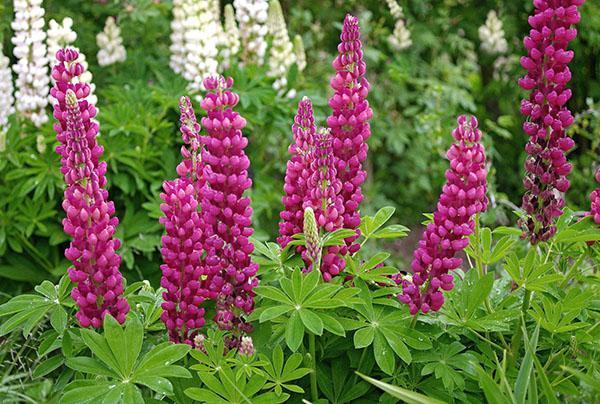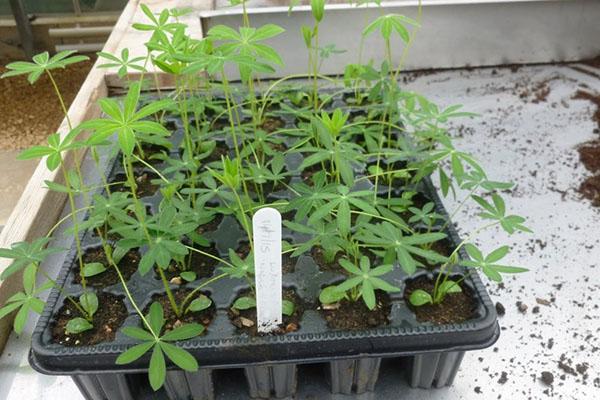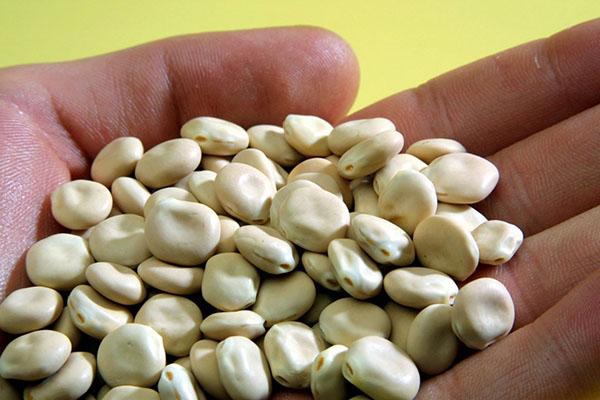Growing lupine from sowing seeds to pest control
 Growing lupine is a favorite pastime of many flower growers. This plant pleases with its colors the whole summer. But only creating comfortable conditions will lead to the appearance of wonderful flowers that will decorate any garden.
Growing lupine is a favorite pastime of many flower growers. This plant pleases with its colors the whole summer. But only creating comfortable conditions will lead to the appearance of wonderful flowers that will decorate any garden.
Seedling lupine from seed

The right time for sowing
 Sowing seeds for future seedlings should be in late winter - early spring. During this period, the air temperature is already stable. To get good seedlings, planting seeds is carried out in warm conditions.
Sowing seeds for future seedlings should be in late winter - early spring. During this period, the air temperature is already stable. To get good seedlings, planting seeds is carried out in warm conditions.
For growing a flower, the type of soil plays a decisive role. The plant feels best in the soil of turf, sand, peat, taken in the same proportion. When planting seeds, the soil should be moderately moist and not loose.
Seedlings
 Before planting seeds for seedlings, they should be specially prepared. Put the seeds in a container, fill with foundation (50% solution), which will increase the degree of germination. Pour the soil into the container, in which to make grooves, each up to 2 cm deep. Remember that for growing lupine it is better to take a large container so that the plants are not cramped. If a large container is not available, it is better to sow fewer seeds. Pour the grains into the grooves and cover them with soil.
Before planting seeds for seedlings, they should be specially prepared. Put the seeds in a container, fill with foundation (50% solution), which will increase the degree of germination. Pour the soil into the container, in which to make grooves, each up to 2 cm deep. Remember that for growing lupine it is better to take a large container so that the plants are not cramped. If a large container is not available, it is better to sow fewer seeds. Pour the grains into the grooves and cover them with soil.
In the case when a warm room is prepared for the seedlings, you can do without feeding the soil with peat. If the cultivation of plants is carried out in a cool place, then mulch the seeds. After 15 days, they will begin to sprout.
Watering the planted seeds should be done from the moment the top layer of the soil dries up. From the second watering, we loosen the ground, but do it carefully so as not to accidentally dig up the seeds. The container with seedlings can be covered with a bag, but periodically cleaned and changed, giving the plants access to air.
Planting seedlings in open ground
 Many novice flower growers are often interested in when to plant lupines in open ground? It is recommended to do this after 20-25 days - during this period the air temperature will already slightly increase. The seedling soil must be pre-moistened and drained. Feel free to plant those seedlings that have thrown out several leaves. Each plant should be placed at a sufficient distance from another, preferably 30-40 cm. Planting should be done very carefully so that the root system is not damaged in the process. Before replanting lupine in spring, it is recommended to discard the sprouts. It is better not to plant the weak and not large enough, since they are unlikely to be able to grow in open areas and will only take up space.
Many novice flower growers are often interested in when to plant lupines in open ground? It is recommended to do this after 20-25 days - during this period the air temperature will already slightly increase. The seedling soil must be pre-moistened and drained. Feel free to plant those seedlings that have thrown out several leaves. Each plant should be placed at a sufficient distance from another, preferably 30-40 cm. Planting should be done very carefully so that the root system is not damaged in the process. Before replanting lupine in spring, it is recommended to discard the sprouts. It is better not to plant the weak and not large enough, since they are unlikely to be able to grow in open areas and will only take up space.
The time of planting a flower on the site
 In the case of plant propagation by seeds, adult specimens may differ from the mother flower. In particular, due to the fact that generic signs are lost, the buds may acquire a different shade. By planting seeds directly in open ground, you will spend less time than seedlings.
In the case of plant propagation by seeds, adult specimens may differ from the mother flower. In particular, due to the fact that generic signs are lost, the buds may acquire a different shade. By planting seeds directly in open ground, you will spend less time than seedlings.
Favorable time for sowing seeds
 Those who want to decorate a flower bed with this flower are often interested in when to plant lupins, if growing from seeds. There is no need to rush this process.Varieties that live for several years tolerate winter well, but with planting it is still better to wait until warm weather sets in. It is best to do this in mid-April. Experienced gardeners say that when lupines are planted in spring at such a time, the flowers will bloom profusely and beautifully, and the plants themselves will exude life and strength. Flowers planted in April will bloom in early summer as early as next year.
Those who want to decorate a flower bed with this flower are often interested in when to plant lupins, if growing from seeds. There is no need to rush this process.Varieties that live for several years tolerate winter well, but with planting it is still better to wait until warm weather sets in. It is best to do this in mid-April. Experienced gardeners say that when lupines are planted in spring at such a time, the flowers will bloom profusely and beautifully, and the plants themselves will exude life and strength. Flowers planted in April will bloom in early summer as early as next year.
The process of sowing seeds in the ground
 Deciding when to plant your seeds is just a fraction of what it takes to properly grow a plant. The whole process does not differ in any complex actions. Before planting lupines in the spring, you need to prepare the ground. Fertilize it with ash, superphosphate, dolomite flour. You should also add clay and sand. Next, you need to make grooves in it in depth from 1.5 to 3 cm.
Deciding when to plant your seeds is just a fraction of what it takes to properly grow a plant. The whole process does not differ in any complex actions. Before planting lupines in the spring, you need to prepare the ground. Fertilize it with ash, superphosphate, dolomite flour. You should also add clay and sand. Next, you need to make grooves in it in depth from 1.5 to 3 cm.
Should I soak lupine seeds before planting? Experienced gardeners definitely recommend doing this. The grains should be left in the foundation solution for a day. This will protect them from pest damage and promote early germination. Sowing is done 2.5-3 cm in the middle of the soil, and on top of the grains are covered with a substrate. Next, a 2 cm layer of peat is laid out on them. The soil needs to be irrigated periodically, and not too much and the frequency should be adjusted based on weather conditions.
Flower care
 Planting and caring for perennial lupins is not difficult or costly. For comfort and rapid growth of the flower, it should be periodically fertilized, watered and weeded, removing weeds.
Planting and caring for perennial lupins is not difficult or costly. For comfort and rapid growth of the flower, it should be periodically fertilized, watered and weeded, removing weeds.
Proper care activities include:
- Watering. Irrigation should be carried out depending on the humidity of the weather. If the period is dry and sunny, it is required regular watering... Water should be given infrequently, but in large quantities. Rainwater can be collected, defended and watered.
- Loosening the soil. This is done in order for more and better oxygen to enter the earth. It is also important to get rid of weeds in a timely manner, since they are able not only to occupy a usable area of land, but also to drink all the vital energy of lupine.
- Fertilizer. In the first year, feeding lupine unnecessarily. In the second year, the soil is fertilized with compositions that do not contain nitrogen. In the spring, fertilizing is carried out with the calculation: per meter of land, 5 g of calcium chloride and 15-20 g of superphosphate. Perennial flowers are fertilized once a year in spring.
- Support. Lupins can grow tall, beautiful flowers, but their stems are often brittle and thin. If strong winds are frequent in your area, you need to make a support for the lupine. A wooden stick or garden pole is perfect for this. Tie the flower to the support not too tightly.
- Transfer. Every 3 years, the lupine flowerbed is updated. These can be new flowers from seedlings or seeds, or existing plants in other flower beds. Older flowers bloom less frequently and have fewer flowers.
Before the spring transplant of lupine, you should use the "transshipment" method.
Caring for lupines in the fall includes removing dried parts of the plant. Treat the soil around the flower with fertilizer that does not change the acid-base balance of the soil. Chemical mulch will do. Cultivars with poor cold tolerance require additional protection. For these purposes, a cloth or film will serve. In the process of plant growth and development, the exposure of its root collar is often observed. In this case, you need to fill it up with soil again. The plant can live for about 5 years, after which it grows old and does not bloom. In this case, the flower bed must be completely renewed.
Lupine diseases and measures to control them
 In general, lupine is rarely sick and easy to care for, but there are several dangerous diseases that can affect a flower at any stage of its life cycle.
In general, lupine is rarely sick and easy to care for, but there are several dangerous diseases that can affect a flower at any stage of its life cycle.
The following lupine diseases are found:
- Fusarium. During the period of bud setting and subsequent flowering, the flowers may suddenly wither.This is how Fusarium appears, which affects both leaves and roots. They dry up and rot.
- Phomopsis. If brown spots appear on the petioles and shoots of a plant, then this is a manifestation of phomopsis. Excessive humidity is the catalyst for the disease; the whole plant is gradually affected. As a result, it can dry out completely.
- Ceratophorosis manifests itself as dark spots throughout the plant. The consequences are lack of flowers and drying of the plant.
But don't panic, because all these diseases can be treated. The drug "Fitosporin" is an excellent and fast-acting remedy. It contains active ingredients and copper, which effectively fight various problems. Experienced gardeners continually recommend this product when growing lupine.